长城故宫英语介绍
- 格式:doc
- 大小:107.00 KB
- 文档页数:9
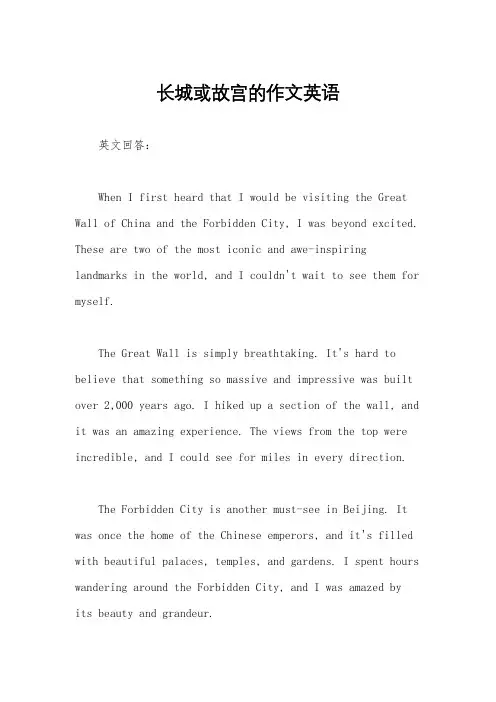
长城或故宫的作文英语英文回答:When I first heard that I would be visiting the Great Wall of China and the Forbidden City, I was beyond excited. These are two of the most iconic and awe-inspiring landmarks in the world, and I couldn't wait to see them for myself.The Great Wall is simply breathtaking. It's hard to believe that something so massive and impressive was built over 2,000 years ago. I hiked up a section of the wall, and it was an amazing experience. The views from the top were incredible, and I could see for miles in every direction.The Forbidden City is another must-see in Beijing. It was once the home of the Chinese emperors, and it's filled with beautiful palaces, temples, and gardens. I spent hours wandering around the Forbidden City, and I was amazed byits beauty and grandeur.Both the Great Wall and the Forbidden City areincredible places, and I'm so glad I had the opportunity to visit them. They're truly two of the most amazing places on earth.中文回答:第一次听说我将参观长城和故宫时,我兴奋不已。
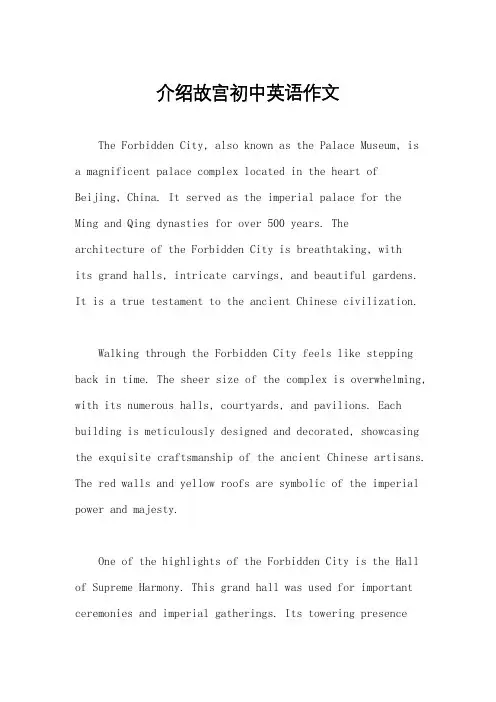
介绍故宫初中英语作文The Forbidden City, also known as the Palace Museum, is a magnificent palace complex located in the heart of Beijing, China. It served as the imperial palace for the Ming and Qing dynasties for over 500 years. Thearchitecture of the Forbidden City is breathtaking, withits grand halls, intricate carvings, and beautiful gardens. It is a true testament to the ancient Chinese civilization.Walking through the Forbidden City feels like stepping back in time. The sheer size of the complex is overwhelming, with its numerous halls, courtyards, and pavilions. Each building is meticulously designed and decorated, showcasing the exquisite craftsmanship of the ancient Chinese artisans. The red walls and yellow roofs are symbolic of the imperial power and majesty.One of the highlights of the Forbidden City is the Hall of Supreme Harmony. This grand hall was used for important ceremonies and imperial gatherings. Its towering presenceand intricate architectural details leave visitors in awe. Another must-see is the Palace of Heavenly Purity, which served as the residence of the emperors. Its opulent interior and beautiful furnishings give a glimpse into the luxurious lifestyle of the imperial family.The Forbidden City is not only a place of historical significance but also a cultural treasure trove. The Palace Museum houses a vast collection of artifacts, including imperial robes, porcelain, calligraphy, and paintings. These artifacts provide valuable insights into the lives of the emperors and the imperial court.Aside from its historical and cultural significance, the Forbidden City also offers a peaceful escape from the bustling city. The palace complex is surrounded bybeautiful gardens and tranquil courtyards, providing a serene atmosphere for visitors to relax and appreciate the beauty of nature.In conclusion, the Forbidden City is a remarkable cultural and historical site that showcases the grandeur ofancient Chinese civilization. Its magnificent architecture, extensive collection of artifacts, and serene surroundings make it a must-visit destination for anyone interested in Chinese history and culture.。
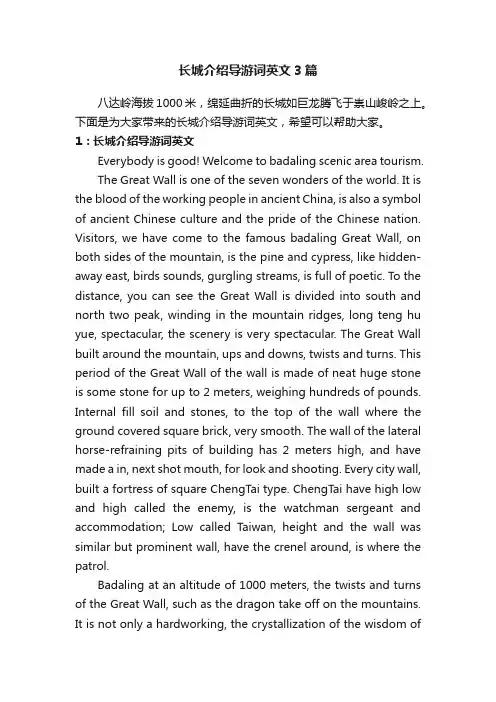
长城介绍导游词英文3篇八达岭海拔1000米,绵延曲折的长城如巨龙腾飞于崇山峻岭之上。
下面是为大家带来的长城介绍导游词英文,希望可以帮助大家。
1:长城介绍导游词英文Everybody is good! Welcome to badaling scenic area tourism.The Great Wall is one of the seven wonders of the world. It is the blood of the working people in ancient China, is also a symbol of ancient Chinese culture and the pride of the Chinese nation. Visitors, we have come to the famous badaling Great Wall, on both sides of the mountain, is the pine and cypress, like hidden-away east, birds sounds, gurgling streams, is full of poetic. To the distance, you can see the Great Wall is divided into south and north two peak, winding in the mountain ridges, long teng hu yue, spectacular, the scenery is very spectacular. The Great Wall built around the mountain, ups and downs, twists and turns. This period of the Great Wall of the wall is made of neat huge stone is some stone for up to 2 meters, weighing hundreds of pounds. Internal fill soil and stones, to the top of the wall where the ground covered square brick, very smooth. The wall of the lateral horse-refraining pits of building has 2 meters high, and have made a in, next shot mouth, for look and shooting. Every city wall, built a fortress of square ChengTai type. ChengTai have high low and high called the enemy, is the watchman sergeant and accommodation; Low called Taiwan, height and the wall was similar but prominent wall, have the crenel around, is where the patrol.Badaling at an altitude of 1000 meters, the twists and turns of the Great Wall, such as the dragon take off on the mountains. It is not only a hardworking, the crystallization of the wisdom ofthe Chinese nation, is also an excellent representative of ancient architecture engineering. The badaling Great Wall, the distant, rolling hills, XiongChen, stiffness of the north to the mountain. Due to the Great Wall and grand Great Wall for to the mountain, to the mountain is more dangerous.Here are the beacon tower, also known as beacons, Wolf yantai. Independent buildings is not connected to the Great Wall. Once the enemy pounce, communicate its kindle wars and light smoke during the day is called "ran, called flint fire at night. When the Ming dynasty, also on the relationship between the war with the enemy made a strict rules: the enemy hundreds, burning a smoke point a gun; Five hundred people, burning two smoke point two guns; More than one thousand people, three smoke SAN pao; More than five thousand people, four smoke four guns; More than ten thousand people, five five gun smoke. In this way, on the border of the military intelligence can rapid transfer to the imperial city ouchi. See the beacon tower, and then tell you a story, called "must play leud" : the zhou dynasty had a king named weeks you king, he has a beautiful woman, her temper is very strange, always don't smile, think of some way to you king. He lit up a distress signal (fire), as a result, drew leud come white, she laughed, you king is also very happy. But, really have an enemy to attack, you king lit the fire, but no one come, and he was killed by the enemy. There is a story, called "meng jiangnu cry Great Wall collapse" : legend was Meng Gusheng a daughter named meng jiangnu. Because of qin shi huang to build the Great Wall, need a lot of manpower. Qin shi huang was caught many people go to the Great Wall.All of a sudden, I do not know where to come up to a rumor: only the wan xi is buried under the Great Wall, can make the GreatWall and solid, qin shi huang was, sent people seize wan xi. Wan xi good fled to Bangladesh. People see wan xi meng home good handsome, talented, good let meng jiangnu and wan xi of their marriage. The two men marry less than 10 days, good wan xi is the rulers who grasp to go to repair the Great Wall. In the fall, meng jiangnu saw her husband hasn't come back, give him the woolies. Along the way, reject, hardships, day and night, all the way to the Great Wall. Local people told her: wan xi good would have buried under the wall. She was grief-stricken, crying. Instantly, and dark, the Great Wall was crying collapsed in eight hundred. Just then, qin shi huang to have the Great Wall, with fine features, when he saw meng jiangnu just want her to do concubine. For qin shi huang meng jiangnu agree to her three conditions: one is for wan xi is a grave; The second is to make good full chao wenwu festivals wan xi; Three is in the middle of the Great Wall and the tomb of wan xi good repair a like flying grand bridge. After three things done, she threw herself into the sea.Visitors, this is three stories about the Great Wall. Now the Great Wall tourist stop here, thank you!2:长城介绍导游词英文Good morning! My name is Chen Ying snow, carefree travel guide, today is a great pleasure to serve you, you can call me snow! Today we are going to visit the Great Wall of landscape is famous in the world. The Great Wall is the world's precious historical relics, hope everyone to love the Great Wall, don't litter scribble, oh!The Great Wall has a long history, a history of more than 2000 years, the spring and autumn period and the warring states period, the warring states to mutual defense, has built the GreatWall in the dangerous place. According to records zuozhuan: in 656 BC, "chu mahjong layout" is about the earliest record of the Great Wall. Out the six nations after the unification of China, qin to defense the north south invasion of the huns, in 224 BC, the qin, zhao and yan in The Three Kingdoms of the north Great Wall, re-hung, coherent rise. Some west about (now min county, gansu province) north mountain, east to liaodong, which is commonly known as the "Great Wall", still remains. Since then, the han, the northern wei dynasty, their, beiqi, sui dynasties had built the Great Wall. The compositionIn Ming dynasty, in order to defense the invasion of alien, built the Great Wall before and after 18 times, total length of 6700 km, east of shanhaiguan, west to jiayuguan, today we visit this section of the Great Wall is built in the Ming dynasty, is located in the badaling.Now we have arrived at the foot of badaling. Tourists friends, please look up at the Great Wall: it is like a huge dragon, winding between mountains. Please follow me to the Great Wall, see: every three hundred meters on the walls of the Great Wall there is a square ChengT ai, is an ancient fortress to station troops. It is said that war, between the ChengTai can mutual echo. On the top of the walls are covered with very flat square brick, like a wide road, probably ErSanTai car can be parallel. Outside the wall along with many more than two meters high, the rows of the crenel, for? With hope and shot. The compositionMy friends, have a look at your feet? Guess what weigh? Tell you! This is a stone, a piece of have two or three one thousand catties! At that time, there is no train, automobile, also have no crane, is by the shoulder of countless countless hands, step by step, carry on the steep mountains. This is how many workingpeople sweat and wisdom, to condense into the former does not see the head, after see the tail of the Great Wall!This is the Great Wall! This is the west jiayuguan, east to shanhaiguan, which meet the sea sunrise and gobi desert sun, or turned on the peaks, or bent over in the valley, the ups and downs, stretching thousands of miles of the Great Wall. It is such a magnificent verve, Great Wall is a great miracle in the history of the world!Dear visitors, today's visit here will be over, thank you very much for my support and cooperation. The majestic Great Wall forever awaits respectfully you the presence!3:长城介绍导游词英文Everybody is good! Welcome to badaling scenic area tourism. Accompany you visit together, today I am very happy, hope all can spend a good time in badaling.Right now, I would go to visit the doorBadaling Great Wall, and now, I'll about matters needing attention: the Great Wall is one of the famous wonders of the world, it is like a dragon entrenched in north China's vast land. It is the crystallization of labor people's blood law in ancient China, is also a symbol of ancient Chinese culture and the pride of the Chinese nation, please don't scribble on the brick fluidized.Visitors, now we have come to the famous badaling Great Wall, to the distance, you can see the Great Wall is divided into south and north two peak, winding in the mountain ridges, long teng hu yue, spectacular, the scenery is very spectacular. Look here is a two openings and u-shaped walls satin afraid brought to the barbican. Both inside and outside the barbican wall on both sides have the crenel wall, all defensive ring. If the enemy breached close into the city, will have been all around guardingcity will panic in the enemy like fall in the urn. The barbican is an important part of the Great Wall. It is generally built on terrain dangerous traffic arteries. Badaling the barbican is no exception. Built on the ridge, restricted by terrain, mountain potential, low west high east, east narrow width, only 5000 square meters. There is no hole in the barbican, lack of water, usually few troops, guarding city forces in the northwest three mile fork city. Barbican in a "examine the courtyard mansion", the original is stay accommodation for the emperor passed in or officials. Barbican 63.9 meters apart, between the two door XiMenMei TiE "north gate lock-and-key", it meant I have spoken in front.City on the doorway, ancient into install a huge double wooden door, door installation has wooden needle and latches. At ordinary times, both doors open and the pedestrian travel free access; Wartime gate closed, sealed hard; Once struck back order, city door is the export of hammering dashed forward. Barbican east gate lintel TiE as "the agent to fill", built during Ming jiajing eighteen years. Town "outside" the commonplace GuanCheng city on the stage, the original is embedded with a piece of stone, is the Ming wanli years of print. From the inscriptions could look around the Great Wall, has the more than 80 years time to complete. This tablet is a record of construction time, length of the Great Wall and the officer and tube foreman, burning head, head of the potter, mason head and name, in order to make clear the responsibility. Stand to look down on the city, we see in constant traffic and visitors through the door. Here is not only an important military defense of the ancient barrier, but also traffic arteries. From here, nantong changping, Beijing, north to yanqing, northwest to xuanhua, zhangjiakou, "convenient way from now on,". Badaling is hence the name.When we came to linhai Great Wall, at the foot of the Great Wall, look up, the endless winding high steps, as if is a path to a blue sky of the ladder, and he seems like a dragon hou lie in rolling peaks.Along the stairs up, came to the first gate "range gate", the ancient scene immediately appear at present, the gate is a two layers of ancient buildings, two sides of the ancients of flags fluttering, increased the antique appeal. The second floor is "clearly" lake mountain, standing there, "the east lake park" as a painting, panoramic view, I'd like to bring a "lake mountain" may be just that.The walk, we came to the second gate "Gu Jing floor", standing on the roof of almost half of linhai city is clearly visible. Go up again, we finally boarded the highest floor of the Great Wall "Bai Yunlou", "finally finished!" I shouted happily. Standing on the "Bai Yunlou", panoramic view of the city, you see the white tower is the tallest building in linhai city, the distance of the "white band" is the yongning river to the sea.At this time I did not notice the blue brick flies in the Great Wall of build by laying bricks or stones into unknown vines ran over the walls, the road also becomes steep, some had split seam, grow a lot of tough grass, perhaps this is the qi jiguang to fight the enemy left scar, it records the history Chinese people surrender, records the long time of the ancient Great Wall. Thought of here, my eyes emerged when the dust float in the sky of the battlefield. One by one the good children, risking their lives, victory over the enemy again and again. The series of trace on the Great Wall, the recorded under a thrilling spectacle.。
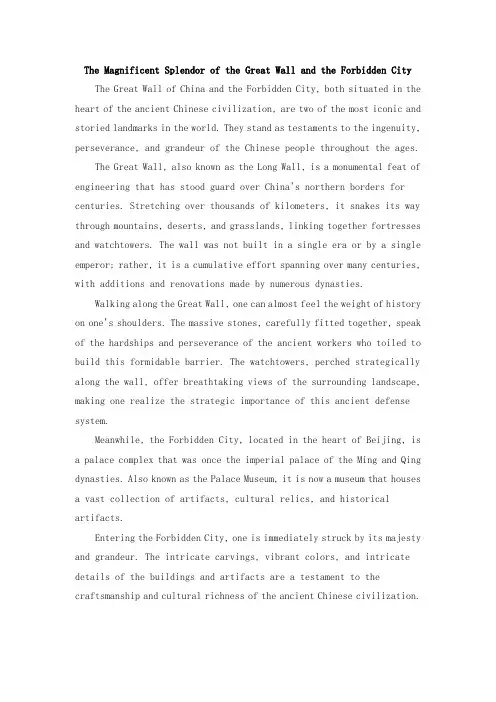
The Magnificent Splendor of the Great Wall and the Forbidden City The Great Wall of China and the Forbidden City, both situated in the heart of the ancient Chinese civilization, are two of the most iconic and storied landmarks in the world. They stand as testaments to the ingenuity, perseverance, and grandeur of the Chinese people throughout the ages.The Great Wall, also known as the Long Wall, is a monumental feat of engineering that has stood guard over China's northern borders for centuries. Stretching over thousands of kilometers, it snakes its way through mountains, deserts, and grasslands, linking together fortresses and watchtowers. The wall was not built in a single era or by a single emperor; rather, it is a cumulative effort spanning over many centuries, with additions and renovations made by numerous dynasties.Walking along the Great Wall, one can almost feel the weight of history on one's shoulders. The massive stones, carefully fitted together, speak of the hardships and perseverance of the ancient workers who toiled to build this formidable barrier. The watchtowers, perched strategically along the wall, offer breathtaking views of the surrounding landscape, making one realize the strategic importance of this ancient defense system.Meanwhile, the Forbidden City, located in the heart of Beijing, is a palace complex that was once the imperial palace of the Ming and Qing dynasties. Also known as the Palace Museum, it is now a museum that houses a vast collection of artifacts, cultural relics, and historical artifacts.Entering the Forbidden City, one is immediately struck by its majesty and grandeur. The intricate carvings, vibrant colors, and intricate details of the buildings and artifacts are a testament to the craftsmanship and cultural richness of the ancient Chinese civilization.The Hall of Supreme Harmony, the largest building in the complex, stands as a symbol of imperial power and authority.Wandering through the Forbidden City, one can almost imagine the bustling activities that once took place here. The courtyards, palaces, and temples are filled with stories of emperors, concubines, eunuchs, and courtiers who once lived and worked here. The artifacts and relics on display offer a window into the past, allowing visitors to glimpse into the lives and cultures of the ancient Chinese.In conclusion, the Great Wall and the Forbidden City are not just tourist attractions; they are cultural icons that represent the rich history and heritage of China. They are reminders of the ingenuity, perseverance, and grandeur of the Chinese people, and they continue to inspire and awe visitors from all over the world.。
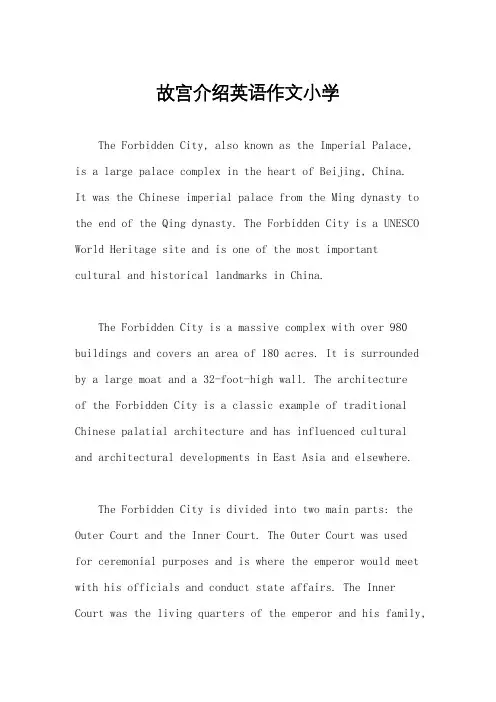
故宫介绍英语作文小学The Forbidden City, also known as the Imperial Palace,is a large palace complex in the heart of Beijing, China.It was the Chinese imperial palace from the Ming dynasty to the end of the Qing dynasty. The Forbidden City is a UNESCO World Heritage site and is one of the most importantcultural and historical landmarks in China.The Forbidden City is a massive complex with over 980 buildings and covers an area of 180 acres. It is surrounded by a large moat and a 32-foot-high wall. The architectureof the Forbidden City is a classic example of traditional Chinese palatial architecture and has influenced cultural and architectural developments in East Asia and elsewhere.The Forbidden City is divided into two main parts: the Outer Court and the Inner Court. The Outer Court was usedfor ceremonial purposes and is where the emperor would meet with his officials and conduct state affairs. The Inner Court was the living quarters of the emperor and his family,as well as the location of the emperor's private audience hall and the imperial garden.The Forbidden City is home to a vast collection of Chinese art and artifacts, including paintings, ceramics, calligraphy, and decorative objects. Many of theseartifacts are on display in the various halls and galleries throughout the complex, providing visitors with a glimpse into the rich cultural heritage of China.Visitors to the Forbidden City can also explore the beautiful gardens and courtyards, as well as the ceremonial and living spaces of the emperors. The complex is a popular tourist destination and attracts millions of visitors from around the world each year.In conclusion, the Forbidden City is a must-see destination for anyone interested in Chinese history and culture. Its stunning architecture, rich collection of art and artifacts, and historical significance make it a truly unique and fascinating place to visit.。
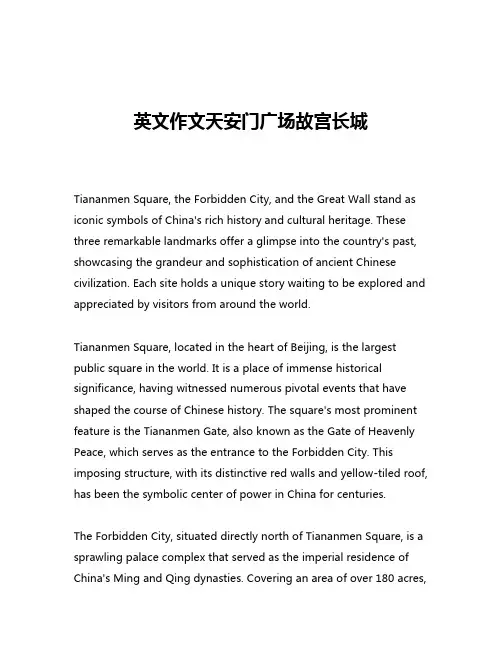
英文作文天安门广场故宫长城Tiananmen Square, the Forbidden City, and the Great Wall stand as iconic symbols of China's rich history and cultural heritage. These three remarkable landmarks offer a glimpse into the country's past, showcasing the grandeur and sophistication of ancient Chinese civilization. Each site holds a unique story waiting to be explored and appreciated by visitors from around the world.Tiananmen Square, located in the heart of Beijing, is the largest public square in the world. It is a place of immense historical significance, having witnessed numerous pivotal events that have shaped the course of Chinese history. The square's most prominent feature is the Tiananmen Gate, also known as the Gate of Heavenly Peace, which serves as the entrance to the Forbidden City. This imposing structure, with its distinctive red walls and yellow-tiled roof, has been the symbolic center of power in China for centuries.The Forbidden City, situated directly north of Tiananmen Square, is a sprawling palace complex that served as the imperial residence of China's Ming and Qing dynasties. Covering an area of over 180 acres,the Forbidden City is a masterpiece of traditional Chinese architecture, featuring intricate designs, ornate decorations, and a harmonious blend of various architectural styles. The sheer scale and grandeur of the Forbidden City are truly awe-inspiring, with its numerous pavilions, courtyards, and gardens offering a glimpse into the lavish lifestyle of China's former emperors.One of the most remarkable aspects of the Forbidden City is its attention to detail and symbolic significance. Every element, from the placement of the buildings to the colors used in the decorations, holds a deeper meaning rooted in Chinese philosophy and tradition. For instance, the use of the number nine, which was considered the most auspicious number in ancient China, can be seen throughout the complex, with nine-story towers and nine-dragon carvings adorning the roofs.Venturing beyond the confines of Beijing, the Great Wall of China stands as a testament to the ingenuity and engineering prowess of ancient Chinese civilization. Stretching across thousands of miles, the Great Wall was built over centuries as a defensive structure to protect the Chinese empire from various nomadic invasions. The sheer scale and grandeur of the Great Wall are truly breathtaking, as it snakes its way across rugged mountains and steep terrain, offering panoramic vistas of the surrounding landscape.One of the most captivating aspects of the Great Wall is its ability to adapt to the natural environment. The wall's builders skillfully navigated the challenging terrain, incorporating natural features such as ridges and cliffs into the design to create a formidable defensive system. The Great Wall's strategic placement and innovative construction techniques have made it a marvel of engineering, standing as a testament to the ingenuity and determination of the Chinese people.Beyond its military significance, the Great Wall has also become a symbol of unity and national pride for the Chinese people. The construction of the wall required the collective effort of countless workers and soldiers over many generations, and its enduring legacy has become a source of inspiration and cultural identity for the Chinese nation.Visiting these three iconic landmarks – Tiananmen Square, the Forbidden City, and the Great Wall – offers a unique opportunity to immerse oneself in the rich tapestry of Chinese history and culture. Each site presents a captivating story, inviting visitors to explore the intricate details, understand the deeper meanings, and gain a deeper appreciation for the enduring legacy of ancient Chinese civilization.As one traverses these historic sites, one cannot help but be struck by the sheer scale, grandeur, and attention to detail that characterizethese remarkable landmarks. The Tiananmen Gate, with its imposing presence, serves as a gateway to the Forbidden City, a sprawling palace complex that showcases the opulence and power of China's imperial past. The Great Wall, meandering across the rugged terrain, stands as a testament to the ingenuity and determination of the Chinese people, who overcame formidable challenges to construct this engineering marvel.These three iconic landmarks not only captivate the senses but also challenge the mind, inviting visitors to delve deeper into the rich tapestry of Chinese history and culture. Through the exploration of these sites, one can gain a deeper understanding of the values, beliefs, and traditions that have shaped the Chinese civilization over the centuries.In conclusion, Tiananmen Square, the Forbidden City, and the Great Wall are not merely tourist destinations but rather living monuments that embody the essence of China's enduring legacy. These iconic landmarks offer a window into the past, allowing visitors to connect with the rich cultural heritage of this ancient civilization. By immersing oneself in these remarkable sites, one can gain a newfound appreciation for the enduring spirit and resilience of the Chinese people, whose collective efforts have left an indelible mark on the world.。
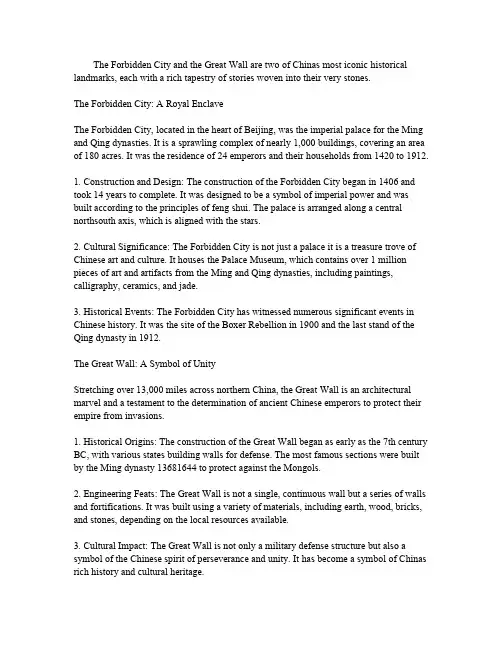
The Forbidden City and the Great Wall are two of Chinas most iconic historical landmarks,each with a rich tapestry of stories woven into their very stones.The Forbidden City:A Royal EnclaveThe Forbidden City,located in the heart of Beijing,was the imperial palace for the Ming and Qing dynasties.It is a sprawling complex of nearly1,000buildings,covering an area of180acres.It was the residence of24emperors and their households from1420to1912.1.Construction and Design:The construction of the Forbidden City began in1406and took14years to complete.It was designed to be a symbol of imperial power and was built according to the principles of feng shui.The palace is arranged along a central northsouth axis,which is aligned with the stars.2.Cultural Significance:The Forbidden City is not just a palace it is a treasure trove of Chinese art and culture.It houses the Palace Museum,which contains over1million pieces of art and artifacts from the Ming and Qing dynasties,including paintings, calligraphy,ceramics,and jade.3.Historical Events:The Forbidden City has witnessed numerous significant events in Chinese history.It was the site of the Boxer Rebellion in1900and the last stand of the Qing dynasty in1912.The Great Wall:A Symbol of UnityStretching over13,000miles across northern China,the Great Wall is an architectural marvel and a testament to the determination of ancient Chinese emperors to protect their empire from invasions.1.Historical Origins:The construction of the Great Wall began as early as the7th century BC,with various states building walls for defense.The most famous sections were built by the Ming dynasty13681644to protect against the Mongols.2.Engineering Feats:The Great Wall is not a single,continuous wall but a series of walls and fortifications.It was built using a variety of materials,including earth,wood,bricks, and stones,depending on the local resources available.3.Cultural Impact:The Great Wall is not only a military defense structure but also a symbol of the Chinese spirit of perseverance and unity.It has become a symbol of Chinas rich history and cultural heritage.Connecting the TwoWhile the Forbidden City and the Great Wall serve different purposes,they are both integral parts of Chinas historical narrative.The Forbidden City represents the centralized power and cultural richness of the Chinese imperial court,while the Great Wall symbolizes the countrys strength and determination to protect its borders.Both sites attract millions of visitors each year,who come to marvel at the architectural grandeur and learn about the stories of the emperors,concubines,soldiers,and common people whose lives were intertwined with these monumental structures.In conclusion,the Forbidden City and the Great Wall are not just historical sites they are living testaments to Chinas past,present,and future.They continue to inspire awe and respect,serving as reminders of the enduring legacy of Chinese civilization.。
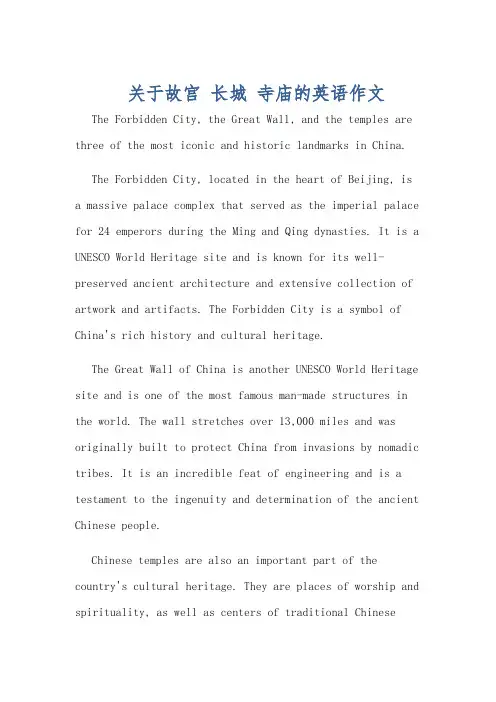
关于故宫长城寺庙的英语作文The Forbidden City, the Great Wall, and the temples are three of the most iconic and historic landmarks in China.The Forbidden City, located in the heart of Beijing, is a massive palace complex that served as the imperial palace for 24 emperors during the Ming and Qing dynasties. It is a UNESCO World Heritage site and is known for its well-preserved ancient architecture and extensive collection of artwork and artifacts. The Forbidden City is a symbol of China's rich history and cultural heritage.The Great Wall of China is another UNESCO World Heritage site and is one of the most famous man-made structures in the world. The wall stretches over 13,000 miles and was originally built to protect China from invasions by nomadic tribes. It is an incredible feat of engineering and is a testament to the ingenuity and determination of the ancient Chinese people.Chinese temples are also an important part of the country's cultural heritage. They are places of worship and spirituality, as well as centers of traditional Chinesearchitecture and art. Many temples in China are dedicated to Buddhism, Taoism, or Confucianism, and they often feature stunning gardens, intricate woodcarvings, and beautiful statues.These three landmarks are not only important symbols of China's history and culture, but they also attract millions of visitors from around the world each year. They are must-see destinations for anyone interested in learning about China's rich and diverse heritage.故宫、长城和寺庙是中国最具标志性和历史悠久的地标之一。
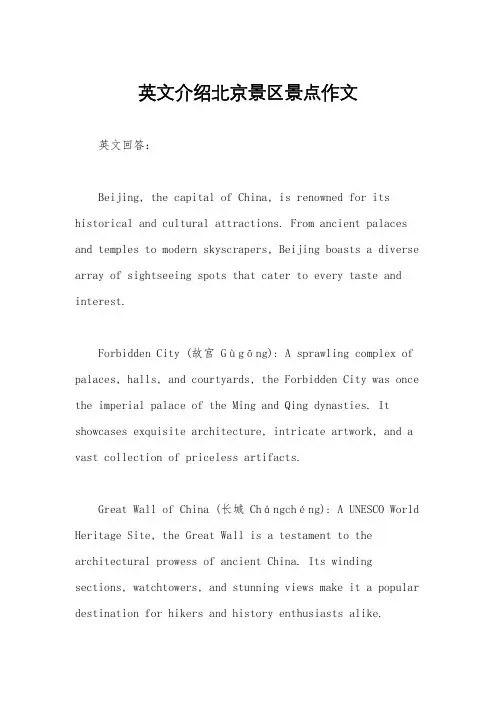
英文介绍北京景区景点作文英文回答:Beijing, the capital of China, is renowned for its historical and cultural attractions. From ancient palaces and temples to modern skyscrapers, Beijing boasts a diverse array of sightseeing spots that cater to every taste and interest.Forbidden City (故宫Gùgōng): A sprawling complex of palaces, halls, and courtyards, the Forbidden City was once the imperial palace of the Ming and Qing dynasties. It showcases exquisite architecture, intricate artwork, and a vast collection of priceless artifacts.Great Wall of China (长城Chángchéng): A UNESCO World Heritage Site, the Great Wall is a testament to the architectural prowess of ancient China. Its winding sections, watchtowers, and stunning views make it a popular destination for hikers and history enthusiasts alike.Temple of Heaven (天坛Tiāntán): A serene park and religious complex, the Temple of Heaven was where emperors performed ceremonies to worship heaven and pray for good harvests. Its circular altars and ornate buildings reflect traditional Chinese beliefs and architectural styles.Summer Palace (颐和园Yíhéyuán): A sprawling masterpiece of landscape architecture, the Summer Palace served as the summer retreat for the Qing emperors. Its gardens, lakes, and pavilions provide a tranquil escapefrom the hustle and bustle of city life.Tiananmen Square (天安门广场Tiānānmén Guǎngchǎng): The largest public square in the world, Tiananmen Square is a symbol of both China's history and its present. It is the site of important political events and cultural celebrations.Houhai Lake (后海Hòuhǎi): A picturesque lake in the heart of Beijing, Houhai Lake is lined with traditional courtyard houses, bars, and restaurants. It offers acharming setting for strolling, boating, or enjoying a leisurely meal.798 Art Zone (798艺术区Qījiǔbā Yìshùqū): Housed in former factory buildings, 798 Art Zone is a vibrant cultural hub with galleries, studios, and art exhibitions. It showcases contemporary Chinese art and provides a glimpse into the city's artistic scene.Beijing Zoo (北京动物园Běijīng Dòngwùyuán): Home to over 10,000 animals from around the world, Beijing Zoo is a popular destination for families and animal lovers.Its pandas, elephants, and tigers are among its star attractions.Beijing Olympic Park (北京奥林匹克公园BěijīngÀolínpǐkè Gōngyuán): Built for the 2008 Olympics,this sprawling park includes the iconic Bird's Nest stadium and the Water Cube aquatic center. It offers a variety of sports facilities and green spaces for recreation and relaxation.Jingshan Park (景山公园Jǐngshān Gōngyuán): Perched atop a hill overlooking the Forbidden City, Jingshan Park provides panoramic views of the city. Its pavilions, gardens, and ancient trees create a serene and picturesque setting.中文回答:北京,作为中国的首都,以其历史和文化景点而闻名。
关于长城故宫英语介绍 ———————————————————————————————— 作者: ———————————————————————————————— 日期:
ﻩSusanna:Wow! What grand buildings! Why are the roofs of most buildings yellow?ﻫ苏珊娜:哇哦!多么宏伟的建筑啊!为什么大多数建筑的房顶都是黄色的呢? Jane:Because yellow was a symbol of imperial power in ancient China.ﻫ简:因为黄色在中国古代象征着皇室权力。 Susanna:What are those animals that are carved on the stones? 苏珊娜:那些刻在石头上的是什么动物?ﻫKangkang:They are dragons. It's said that they're powerful animals which guard the whole nation. In ancient China, emperors thought that they themselves were real dragons and the sons of Heaven. 康康:它们是龙。据说它们是守护整个国家的神兽。在古代中国,皇帝们都认为自己是真龙天子。ﻫJane:And the dragon has become a symbol of the Chinese nation.ﻫ简:龙成了中华民族的一个象征。ﻫKangkang:That's correct! It also plays an important part in Chinese festivals. 康康:没错!龙在中国节日中也扮演着重要的角色。ﻫSusanna:How interesting! Anything else about dragons? 苏珊娜:太有趣了!还有其他与龙有关的吗?ﻫKangkang:Yes, there are a lot of operas, music, paintings and sayings about dragons.ﻫ康康:有,有很多与龙有关的戏剧、音乐、画作和谚语。
The Great Wall 长城 The Great Wall of China is one of the greatest wonders of the world.ﻫ中国长城是世界上最伟大的奇观之一。 The entire wall, which has many branches, is about 8 800 kilometers long.ﻫ长城有很多分支,总长度达8800千米。 It stretches from Shanghaiguan in the east to Jiayuguan in the west.ﻫ它从东部的山海关绵延至西部的嘉峪关。ﻫThe construction was begun during the warring states period, which was about 2 500 years ago. 长城的建造始于战国时期,大约是2500年以前。ﻫThe states of Qin, Wei, Zhao, Qi, Yan and Zhongshan all built walls to protect their people. 秦、魏、赵、齐、燕以及中山都曾建造长城保护自己的子民。 The first emperor, Qin Shihuang, joined all these smaller walls together to make the Great Wall.ﻫ第一位皇帝秦始皇将长城的所有小墙连接起来,建成长城。 These early walls that were made of packed earth and wood wore away in the rain and wind. 早期用泥土和木头做的墙经过风吹雨打后都有所磨损。ﻫLittle of these walls remain. Most of the Great Wall that can be seen today was built during the Ming dynasty.ﻫ很少一部分残留了下来。今天我们看到的长城多数都是建于明朝。 It was made of stone and brick that would last longer. 它是由石头和砖块造成的,持续时间更久。ﻫThe Great Wall was first
built by ancient people to separate them from their enemies.ﻫ古代人建造长城是为了阻挡敌人。ﻫThose Ming dynasty rulers did not expect that it would later be used to bring tourists into China. 明朝的统治者并没有想到长城日后竟然会吸引游客到中国来。 It is said that he who has never been to the Great Wall is not a true man.ﻫ据说不到长城非好汉。ﻫThe Great Wall is a treasure of Chinese civilization and it is regarded as a symbol of the Chinese nation. 长城是中华文化的瑰宝,也是中华民族的象征。
The home of tea, which has more than 4 000 years of history, is China. 有着4000多年历史的茶之乡是中国。 People throughout China drink tea daily.ﻫ全中国的人们每天都喝茶。ﻫOf the three major drinks--tea, coffee and cocoa, tea is drunk by the largest number of people in the world. 在茶、咖啡和可可这三种主要的饮品中,茶在世界上的饮用人数最多。ﻫTea from China, along with silk and porcelain, began to be known by the world over a thousand years ago and has been an important Chinese export since then.ﻫ一千多年前,来自中国的茶叶、丝绸和瓷器就闻名世界,从那时起便是中国重要的出口物资。 The words for "tea" in different languages came from the Chinese character, "cha".ﻫ不同语言中的“茶”来自汉字中的“茶”。 The English word, "tea", sounds similar to the Pronunciation of it in Xiamen, Fujian province. 英语中“tea”的发音与福建省厦门对“茶”的发音很相似。 The Russians call it "cha'i", which sounds like "chaye" (tea leaves) as it is pronounced in northern China.ﻫ俄罗斯人将其称为“茶衣”,听起来很像中国北方所说的“茶叶”(茶树的叶子)。ﻫThe Japanese character for "tea" is written exactly the same as it is in Chinese, thought it is pronounced a little differently. 日语对“茶”的写法与汉字一模一样,不过发音上有细微差别。 Tea leaves are produced mainly in the south of China because of the mild climate and rich soil there. 茶叶主要产在中国南方,因为那里有温和的气候和肥沃的土壤。 Longjing, Pu'er, Wulong and Tieguanyin are all famous teas. 龙井、普洱、乌龙和铁观音都是很出名的茶。 They're produced in the provinces of Zhejiang, Yunnan and Fujian.ﻫ它们的出产地在浙江、云南和福建。 Over the past centuries, Chinese people have developed their unique tea culture, including tea planting, tea-leaf picking, tea making and tea drinking. 过去的几百年间,中国人发展出了自己独特的茶文化,包括种茶、采茶、制茶和品茶。ﻫTea is aslo a popular topic in dances, songs, poems and novels. 茶在舞蹈、歌曲、诗歌和小说中也是很受欢迎的主题。